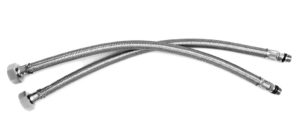 While hose clamps are traditionally used to seal or attach a hose to a fitting for automotive purposes, they can be useful in a variety of household projects as well. Whether it’s mounting road signs or temporarily fixing plumbing issues, you can find a multitude of hose clamps for your project.
While hose clamps are traditionally used to seal or attach a hose to a fitting for automotive purposes, they can be useful in a variety of household projects as well. Whether it’s mounting road signs or temporarily fixing plumbing issues, you can find a multitude of hose clamps for your project.
However, before you begin your project it’s essential to first determine which types of hose clamps will be right for the job. The following are the most common types of hose clamps and how they can best be used.
Screw clamps
A screw hose clamp is typically used to attach hoses that are one-half inch in diameter and up. These stainless steel clamps work best in emergencies such as fixing damaged commercial pipes or in domestic wastewater piping.
To use a screw clamp, loop the stainless steel clamp around the hose you want to fit to the barb or nipple. Feed the loose end of the screw into the area between the captive screw and the band. It’s this screw thread cut of the band that gives this clamp its name. Once you’ve turned the screw, the band on the clamp will tighten around the hose.
Wire clamps
Another reliable clamp for a potential project includes the wire clamp. These clamps are made from heavy wire that’s been twisted into a “U.” One end of the U overlaps the other end, thereby creating a ring. These clamps are made from hand with wire cutters, a riveter, pliers, and a stainless steel wire.
To use a wire clamp to close on the end of a hose, loop the hose through the wire and fix it to the barb or nipple. Once the hose has been fixed, tighten the clamp by turning the captive screw on one end of the bent wires. Turning the captive screw forces apart the ends of the wires, which tightens the loop around the hose.
Ear clamps
If the project you’re using hose clamps for requires a clamp that will accommodate the expanding and contracting nature of the hose, an ear clamp is the one for the job. These types of hose clamps place a concentrated pressure on the hose and are designed to employ tamper resistance.
To use ear clamps for your project, loop the hose through the clamp and tighten the clamp using the ears along the band using a pincer tool. Because the clamp becomes permanently deformed as the ears are tightened, these clamps are best used for heavy duty jobs.
Hose clamps can be used for a wide variety of household and commercial projects. Whether you need to fix the pipes under your sink or need something for your automotive vacuum hose, there’s a hose clamp somewhere that’s perfect for the job.

